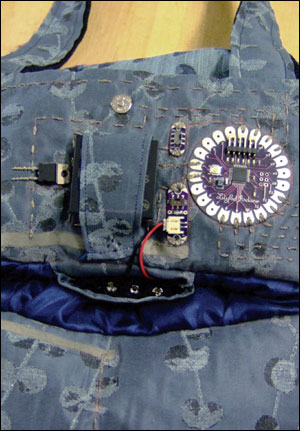With a mission to apply emerging technologies to everyday life, two students at MIT Media Lab developed a ladies’ handbag designed to ensure you don’t forget your mobile phone, wallet and other essentials. Dubbed Déjà Vu, the bag has a built-in RFID reader with indicator lights showing whether items you’ve tagged are inside.
Déjà Vu is the brainchild of Heidi Chen and Nicole Tariverdian—Tariverdian is actually a graduate student at Massachusetts College of Art and Design, and her interest is in tangible electronic interfaces (as opposed to on-screen interfaces). A friend recommended she take New Textiles 2011, a Media Lab class taught by Leah Buechley, an assistant professor of media arts and sciences, and director of the High-Low Tech group, which “investigates the integration of high and low technology from cultural, material and practical perspectives.”

During the year, Chen and Tariverdian teamed up on a project that involved turning the vibration of a mobile phone into flashing LEDs. Then they decided to work together on their final assignment and came up with the concept of a purse that tracks its contents. “I’m always searching for stuff in my handbag,” Tariverdian says, “so it seemed like the perfect project.”
The pair’s biggest challenge involved determining which type of reader would work best. Something that could read all the tags all the time was too large and consumed too much power, so they opted to use ID Innovations’ ID-20, a small 125-KHz RFID reader module.
It reads the low-frequency tags on items as they are placed into the bag.
Another big challenge involved wiring the handbag to provide power from a battery pack to the reader and the LEDs that would light up when a user put, say, a tagged cell phone inside. “We had some problems getting enough power to the reader, but Prof. Buechley helped us out,” Chen says.
Based on feedback from classmates and friends who tested the handbag, Chen and Tariverdian made some changes, such as adding colored embroidery around the white LEDs to help identify the items in the bag. Some male friends recommended a version they’d feel comfortable carrying.
Chen and Tariverdian haven’t made plans for mass production. “It would be fantastic if we could turn this project into an actual product,” Tariverdian says, “but it fits my thesis [at MassArt], so for now, we’re just taking it step by step, and we’ll see where it leads.”

